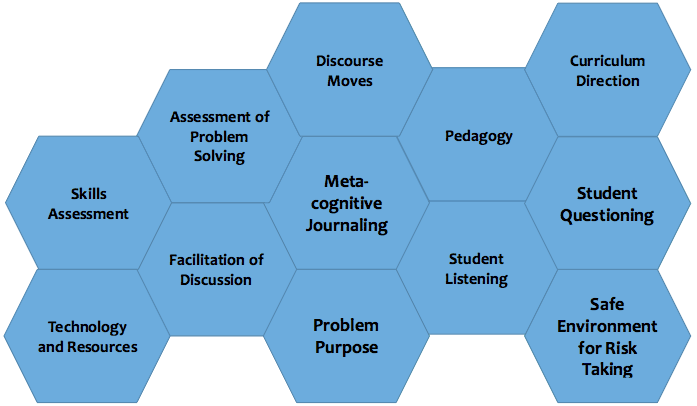By Carmel Schettino, posted September 26, 2016 —
I hope that by this time, everyone has seen Robert Kaplinsky’s amazing NCTM ShadowCon presentation from the Annual Conference in San Francisco this year. If you haven’t, you can find it here
(http://meetings.nctm.org/2016-annual-meeting/empower/). Kaplinsky’s seminar was entitled “Empower,” and his moving call to action was to empower another person or tell someone who empowered you how grateful you are. Anyone who has been lucky enough to have had an amazing mentor may have
thought many times of trying to find a way to pay it forward. In my case, I had many who introduced me to problem-based learning (PBL), pushed me to be a better teacher, and inspired me to continue striving to improve my practice. When I write or talk about PBL, I guess that’s my way of responding to Kaplinsky’s call,
but I am also responding to increasing interest in a current national trend in mathematics education.
Since the NCTM Principles and Standards for
School Mathematics (2000) included the Process Standards, the Common Core State Standards for Mathematics (2010) detailed its Standards for Mathematical Practice. And most recently, the NCTM Principles to
Actions: Ensuring Mathematical Success for All (2014) outlined essential Mathematics Teaching Practices. Now math teachers all over the United States have been clamoring for help in how to implement these practices in their classrooms. What do these three
publications have in common? They call for more focus on reasoning and sense making, allowing for more student discourse, supporting productive struggle for students, and trying to see evidence of student thinking in their work. In my opinion, these focal points move teachers to be interested in problem-based
learning and to seek ways to implement PBL more and more in their classrooms.
What is funny, though, is that PBL has been around for a very long time (as opposed to project-based learning (PjBL). It started in the 1960s at the medical school level (Barrows, McMaster University) and was also used at the college level for math majors by R. L. Moore (see
Coppin, The Moore Method, MAA 2009) for a long time. The basic tenets of this being to “elevate students from recipients to creators of knowledge” and to have in-class time for to students “present and debate mathematics.”
The idea of centering the classroom environment around problems and students’ ideas about them—as opposed to around the teacher and his or her authority about the mathematics—is rather novel. Students have prior knowledge and experience that they do not have readily available until it is triggered by a problem that
relates to the previous one. The problems in a PBL curriculum need to be scaffolded in such a way that students are made ready for what is coming next. If this does not happen, then they will be unable to access their prior knowledge.
It might not take a lot of convincing that this type of teaching directly speaks to many of the practice standards and recommended teaching practices, but for many teachers, it does take convincing that it has value and can be accessible to all students. It also is not as easy as it sounds. Teachers may face many
obstacles when moving toward this type of pedagogy, and they need to consider a great deal of assessment and classroom strategies at the same time.
Aspects of Problem-Based Teaching (Schettino 2013)

In the next few blogposts, I hope to begin to address some of these aspects and give some direction from my experiences over the past twenty years of teaching with this method.
However, I do agree with Matt Larson: As he said in his great Ignite talk at NCTM this year (https://www.youtube.com/watch?v=zhNqhBltoDQ&feature=youtu.be), finding that balance between meeting students where they are and pushing them to practice these standards is key. Empower them to realize they know more than they think they do. In my experience, PBL does just that.
 With problem-based learning as her specialization, Carmel Schettino obtained a PhD in math education while teaching at the secondary level for more than twenty years. She is passionate about helping teachers grapple with the pedagogical and curricular questions that arise when PBL is brought
into the math classroom. Her other areas of expertise include gender equity, discourse, technological implications and PBL's relationship to the Common Core. Schettino has consulted for a number of schools, has presented for NCTM (e.g., Annual Conferences
2015 and
2016) and has published articles with respect to PBL in the secondary mathematics classroom. Find her blog at
carmelschettino.org, and contact her at
[email protected].
With problem-based learning as her specialization, Carmel Schettino obtained a PhD in math education while teaching at the secondary level for more than twenty years. She is passionate about helping teachers grapple with the pedagogical and curricular questions that arise when PBL is brought
into the math classroom. Her other areas of expertise include gender equity, discourse, technological implications and PBL's relationship to the Common Core. Schettino has consulted for a number of schools, has presented for NCTM (e.g., Annual Conferences
2015 and
2016) and has published articles with respect to PBL in the secondary mathematics classroom. Find her blog at
carmelschettino.org, and contact her at
[email protected].